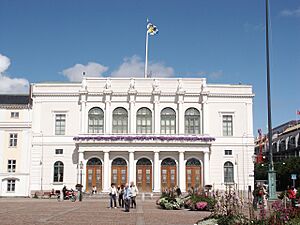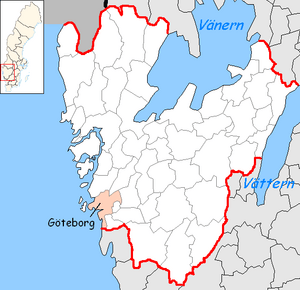Gothenburg Municipality facts for kids
Quick facts for kids
Gothenburg Municipality
Göteborgs kommun
|
||
|---|---|---|

Gothenburg City Hall
|
||
|
||
 |
||
| Country | Sweden | |
| County | Västra Götaland County | |
| Seat | Gothenburg | |
| Area as of January 1, 2010. | ||
| Population
(May 2023)
|
||
| • Total | 600,559 | |
| Time zone | UTC+1 (CET) | |
| • Summer (DST) | UTC+2 (CEST) | |
| ISO 3166 code | SE | |
| Province | Västergötland and Bohuslän | |
| Municipal code | 1480 | |
| Website |
|
|
Gothenburg Municipality (called Göteborgs kommun or Göteborgs stad in Swedish) is a local government area in western Sweden. It is located in Västra Götaland County. The main city and administrative center of this municipality is Gothenburg.
The City of Gothenburg was first established in 1621. In 1863, it became a city municipality with its own elected council. Over the years, the municipality grew bigger by joining with nearby areas. This happened many times between 1868 and 1974.
In 1971, Gothenburg became a single, unified municipality, just like all other municipalities in Sweden. However, it often prefers to call itself Göteborgs stad, which means "City of Gothenburg," whenever it can.
Contents
Areas within Gothenburg Municipality
The main part of the Gothenburg urban area is inside this municipality. But there are also other smaller towns and villages, as well as countryside areas.
Localities and Towns
Here are some of the other towns and localities found within Gothenburg Municipality:
- Billdal (part of)
- Donsö
- Hjuvik
- Nolvik
- Olofstorp
- Styrsö
- Torslanda
- Vrångö
Understanding Boroughs
In 1990, Gothenburg Municipality was divided into 21 smaller areas. These areas are managed by "district boards" (called stadsdelsnämnder in Swedish). Sometimes people call them boroughs, but they are not exactly the same.
These boards are in charge of important services for their local areas. This includes things like primary schools, social support, fun activities, and cultural programs. In 2009, some of these boards were combined. By 2011, there were 10 new, larger district boards.
Some areas, like Askim, Torslanda, and Älvsborg, wanted to become their own separate municipalities. They held local votes in 1998, but the Swedish government did not approve their requests.
Here are the boroughs within Gothenburg Municipality:
- Angered
- Askim
- Backa
- Bergsjön
- Biskopsgården
- Centrum
- Frölunda-Högsbo
- Härlanda
- Kortedala
- Kärra-Rödbo
- Linnéstaden
- Lundby
- Majorna
- Styrsö
- Torslanda
- Tuve-Säve
- Tynnered
- Älvsborg
- Örgryte
Working with Other Cities Globally
Gothenburg Municipality works with cities around the world. This cooperation helps them share ideas and learn from each other.
Twin Towns
Twin towns often have special cultural and social connections.
Partner Cities
Partner cities work together on specific projects or areas of interest.
 Nelson Mandela Bay, South Africa
Nelson Mandela Bay, South Africa Novi Sad, Serbia
Novi Sad, Serbia Lyon, France
Lyon, France
For example, Gothenburg's partnership with Nelson Mandela Bay in South Africa started in 1998. They work together on things like managing waste, public libraries, sports, and tourism. Gothenburg also had an agreement with Shanghai in China, which focused on culture, economy, trade, and sports. This agreement ended in 2020.
Sister Cities
Sister cities also build strong bonds, often focusing on cultural exchange.
Regional Cooperation
Gothenburg also cooperates with cities in its region.
 Oslo, Norway
Oslo, Norway
See also
 In Spanish: Municipio de Gotemburgo para niños
In Spanish: Municipio de Gotemburgo para niños



